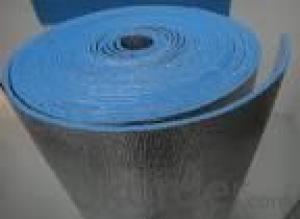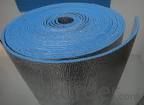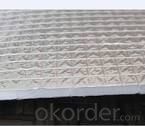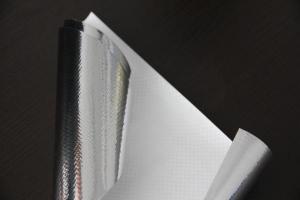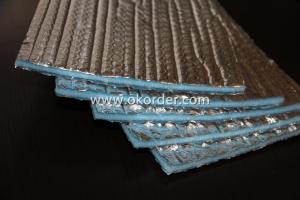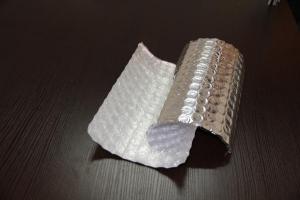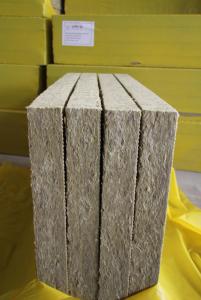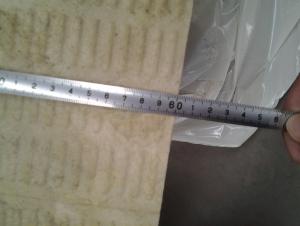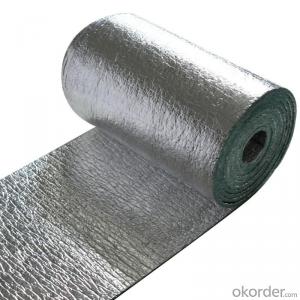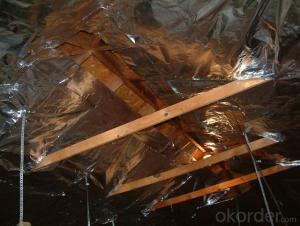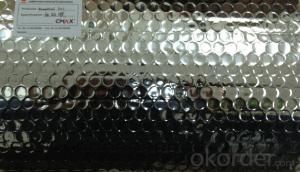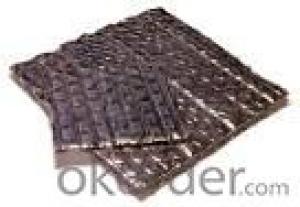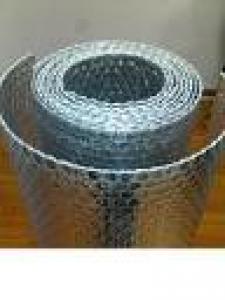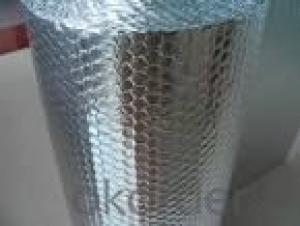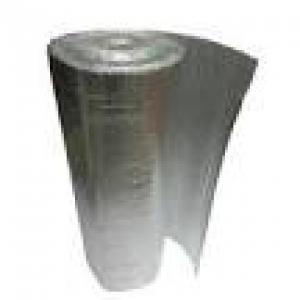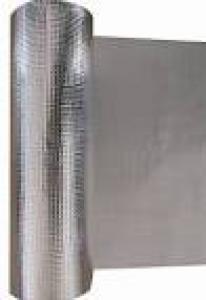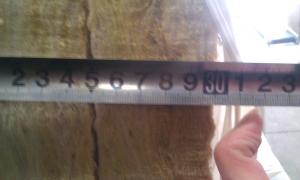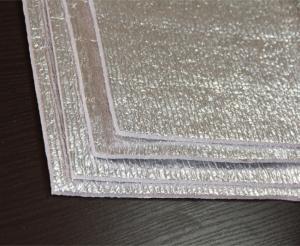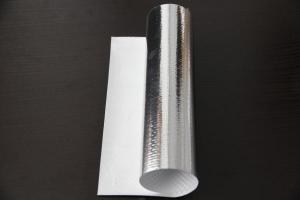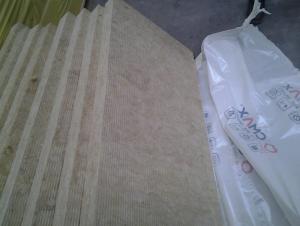Polystyrene Roofing Insulation - Aluminum Foil Coated Bubble Insulation Type 19
- Loading Port:
- Shanghai
- Payment Terms:
- TT OR LC
- Min Order Qty:
- 10000 m²
- Supply Capability:
- 100000 m²/month
OKorder Service Pledge
OKorder Financial Service
You Might Also Like
Bubble Insulation Benefits:
Reflects 96% of radiant heat
Non-toxic / Non-carcinogenic
Does not require protective clothing or respirators to install
Durable and lightweight
Does not compress, collapse or disintegrate
Vapor and radon retarder
Easy to cut and install
Permanent and maintenance-free
Does not provide a growth medium or nutritive value for fungus, insects, or rodents
Does not support the growth of mold or mildew
Not affected by moisture or humidity
Lowers heating and cooling costs year round
Bubble Foil Application:
Metal & Steel Buildings
Homes
Roof Underlayments
Cathedral Ceilings
Crawl Spaces
Hot Water Heaters
Basement Walls
Floors
Garage Doors
Concrete slabs
Driveway snow melts
Pole barns
Post frame buildings
Poultry barns
Animal kennels
Temperature sensitive storage areas
Air Bubble Foil Insulation Tech Data:
Material Structure: AL/Bubble/AL | ||
Bubble Size:D10mm*H 4mm(10*2.5/10*4/10*6/20*7/25*10)choose the bubble size | ||
Bubble Weight:0.13kg/m2 ( can be customized ) | ||
Roll Width:1.2m (lenth can be customized) | ||
PROPERTIES | TEST DATA | UNIT |
Thickness | 3.5-4 | mm |
Weight | 250 | g/m2 |
Emissivity | 0.03-0.04 | COEF |
Thermal conductivity | 0.034 | w/m0 |
Apparent Density | 85 | kg/m3 |
Reflectivity | 95-96 | % |
Water Vapour Transmission | 0.013 | g/m2kpa |
Corrosion | doesn't generate | |
Tensile Strength(MD) | 16.98 | Mpa |
Tensile Strength(TD) | 16.5 | Mpa |
- Q: I have a low pitched roof so there isn't that much room up there hands and knees only.I have no eave ventilation but the ventilation is through the front and back of the house through triagle metal caps cut into the wood siding. I already have some R19 in the ceiling joists but was wondering would putting it in the rafters against the plywood holding the shingles also help insulate the living area of the house.
- Best way and easy cheap way is just roll out unpapered fiberglass over top of joist at right angles to existing insulation
- Q: do i have to have insulation in my roof?
- Maybe, you do need insulation above the ceilings (it will be between the ceiling joists/framing that also serve as the attic floor joists/framing. 1. If you have a finished attic (for a living area of some sort) then yes there should be insulation with a vapor barrier under the roof &/or between the roof framing. This will help keep heating/cooling costs down and prevent condensation from forming under the roof and doing lots of water damage over time. 2. If the attic is partially finished but used for storage only & there is attic ventilation in use also then no you don't need insulation under your roof. 3. If your attic is partially finished or completely finished but used for storage only and there is no attic ventilation then yes you should have insulation with a vapor barrier also under the roof. You don't have to have it since it's used for storage only but if you start to see condensation &/or wet areas on the wood or framing under the roof then you will need insulation with a vapor barrier installed. If for any reason insulation is installed under the roof it must be installed correctly and have in place a proper method of ventilation directly under the roof itself. All roof systems in the attic areas must have proper ventilation to prevent any possibility of condensation forming under &/or in the wood roof framing & sheathing materials that will rot the wood over time.
- Q: the roof of my mouth hurts bad.i worked all day with sawdust and insulation yesterday.is this the problem.?
- it is what might have irritated your mouth. use a mask in the future. for now, increase your fluid intake and try Benedryl for a few days.
- Q: were can i buy material to insulate pans and instructions to install it? I have seen many roofs with this done ,but , the lowe,s and home depots don't have .
- metal pan usually refers to a pan that concrete is then poured into. If there is no concrete in it (and a flat membrane roof over that) then its called currogated metal roof. Either way they look the same. Hard to insulate cause they are not meant to insulate. there are some sold with insulation already attached - its a thin floam layer - thats a newer thing but not sure how new. heard of some mobile home mfgs and storage building builders using spray on insulation under the panels. As for aftermarket on insulating- you may be able to have spray on insulation applied from under neath - if the space is open and accessible. it looks and feels like foam, can get a bit messy , but maybe do-able depnding on your application. If its not a open space with maybe drywall under it - you might think about opening up the space in the ceiling and having blown in insulation done (much cheaper then sprayed on). Blown in will insulate just fine but someone would have to look at your application and area cause in some instances - blown in insulation can be bad for high moisture situations. also- if this happens to be in a house - by adding insulation to steel - you might be breaking fire code - something to keep in mind for safety.
- Q: Would it be worth forwarding the offer to the client? Is the difference that substantial?
- You don't want that. If he offers 3.5 instead of the required 3, that is a different story. Otherwise he should give you more material thickness to provide an equivalent R of 3. Yes, the difference can be substantial and I wouldn't forward it to the client. The smaller the R value of the entire roof sandwich the larger the difference it makes. Like the change from 5 mpg to 4 mpg is a 25% worsening in fuel economy, but a change from 100 mpg to 99 mpg is 1%. It will mess up the heating/cooling of the building and the mechanical systems might be inadequate. They could save money on the roof and complain how the building is too hot/too cold or the mechanical systems never shut off and their energy bills are too high.
- Q: I have a split house with an attic where I have insulation on attic floor, but the house seems to be cold still, Can I add insulation to the roof of the attic? If so, any options? Thank you.
- No, you want the air to circulate from the soffit vent to the ridge vent or gable vents, whichever you may have. This will prevent mold and condensation.
- Q: We had a water leak in our pipes in our foundation and had to re-route our pipes along our roof. We have tried some really basic insulation for piping, but it usually deteriorates very quickly due to sun light and wind. What are some ways we can insulate our pipes effectively without having to re-insulate every month? This has to be something fairly simple and inexpensive. We aren't looking for perfect insulation, just something that will keep the water warm in the winter and cool in the summer.
- Contact a local remodeling contractor and install the new piping system properly. Even a system under a foundation can be repaired, but it is not cheap to do it.
- Q: House is a bi-level. Recently added storm windows to deck off dining room. Having a new rubber roof installed would like to know if we can insulate ceiling to make the room warmer. What product do you suggest we use. we are getting conflicting answers, some say you can insulate others say the ceiling needs to breath having a rubber roof install. Please advise.
- Your other answerer is correct. The little plastic pieces that he speaks of are sometimes called baffles. They look like they are corregated or wavy like the inside of cardboard. These are essential to letting air flow in the attic space. Another item that you must have are vents on the soffits or overhangs on either side of the roof. Air has to get in there somehow. There are alot of homes that are not ventilated properly and the roof decking or plywood gets discolored and rots from the inside out. Sometimes this can happen in as little as 5 years, depending on your geographical location. Rubber roofing is usually put on a flat roof system. If you do not have access to inside the framing, you cannot insulate or it will be very difficult to get insulation in there properly. There are so many variables with different houses and locations. You may want to ask an insulation expert from the phone book or even a home inspector. Good luck.
- Q: What are the roof insulation materials?
- Compared with EPS sheet, XPS board is made of polystyrene resin and other additives by extrusion process has a continuous uniform surface and closed-cell honeycomb structure of the plate, the closed-cell structure of the insulation material can have different The pressure (150-500Kpa) also has the same low thermal conductivity
- Q: I am in the process of having a new roof installed. What are my options in regards to improving its' insulating properties?
- No matter what material you use for the actual roofing, make sure you have a Radiant Barrier installed at the same time. There are several different ways this can be achieved, your roofing contractor can (and should) advise you on the best method for your home.
Send your message to us
Polystyrene Roofing Insulation - Aluminum Foil Coated Bubble Insulation Type 19
- Loading Port:
- Shanghai
- Payment Terms:
- TT OR LC
- Min Order Qty:
- 10000 m²
- Supply Capability:
- 100000 m²/month
OKorder Service Pledge
OKorder Financial Service
Similar products
Hot products
Hot Searches
Related keywords
